Le Basilique de St. Quentin was begun in 1195;
its completion took 300 years. The church has high rayonnant elevation
with double transepts.
Unlike Noyon and Soissons that maintained the
same type of gothic line throughout their periods of construction, St.
Quentin's construction changes with the times. It contains primitive,
classic, rayonnant, flamboyant styles. Nevertheless, it is not
only one of the early gothic structures, it is also an archetypal gothic
in that it incorporates the symbols which point to its function and aim.
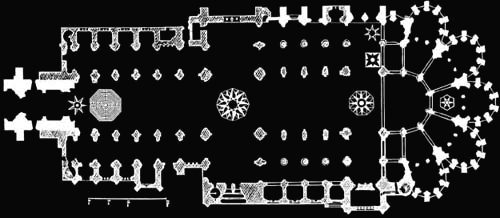
Not very much of this is left in France, because
as portions of those structures which displayed the symbols were reconstructed
or replaced, the symbol was torn out or re- installed incorrectly. Unfortunately,
the clergy had developed a suspicious mind toward the symbols and the practical
use of them. The increasing fanaticism and autocracy in the church is not
hard to trace.
St. Quentin escaped this willful destruction.
Such value was placed on the original that, for instance, when the new
flooring was laid in the sanctuary sometime in the 1300s, the original
floor was transferred up to St. Michael's Chapel.
All gothic cathedrals actively use the function
of orientation. One of the four major spaces is termed the nave, the Latin
root of which means to navigate. (The other three are the transepts, choir/chancel,
and apse.) Orientation's root is orient, east, symbolic position of the
goal of the work of the cathedral. The east is the symbolic place of the
source and emanation-point of all light, and thus life itself... as perceived
via the senses. Sensory orientation, identifying one's locality through
the nervous system, mind, body and emotions, requires four reference points
as demonstrated by the magnetic compass. To operate self-referentially
the senses need space-time, and the four-pointed axis of space-time. (This
attribution of 4- pointedness may be a direct indication of the qualities
in the senses themselves.) The senses of smell, taste, hearing and sight
all verify one another in that they reinforce personal survival impulses.
Through sensing in a non-personal way it is possible to bypass these programs
and connect into real feeling which is the expansive consciousness of being
universal (using this faculty). Real feeling flows into real concentration
and the co-emergent activity of compassion, which is void.
A cultural-mind's representation of the four directions
indicates the orientation of the culture. How any "mind" (Christian, Moslem,
Indian, Buddhist, Aboriginal, Scientific, etc.) may formulate a view of
reality could simply be based on how these "minds" have oriented to east/west-north/south
in terms of up/down-left/right or whatever the correspondence may be. This
cultural orientation is statistically applicable to probabilities within
the context of large sets, but not necessarily applicable to individual
possibilities.
In our modern world where orientation is only
a passing reference flung about by high-tech psychology in the interest
of re-inforcing success-oriented programming, it is difficult to grok
the profound significance that this necessary life-function had for medieval
man. In a time when maps were a precious rarity, a well developed sense
of direction was the only guide through the wild forests of Europe. When
the theologian- philosophers saw the analogy between this practical life-
maintaining function and the orientation that can save a soul, they converted
orientation into a teaching aid which was readily understandable to everyday
people. St. Quentin's uniqueness is that it is an archetype for orientation.
"Orientation" should be understood as the real reason or ground for one's
being, whether or not it complies with any established views of orientation.
It is not only one's individual destiny, but also the fulfillment of all
possibilities in the most all- encompassing way.
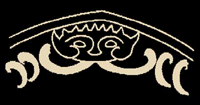
Beginning at the entrance, which was originally
the great western portal: The specific carvings that appear on any of the
porches serve as a focus for instruction, concentrating attention on the
non-phenomenal. The message of the portal is that one leaves the material
concerns outside in the material world. Over this portal is a masque which
is exhaling forms of linked semi-circles. The masque is symbolic of the
artificial, the world of illusory appearances; and the phenomena it perpetuates
are the endless chains of half-truths, partially conscious views of reality
posing as a totality.
Beyond the portal, between the floor and the organ
loft (which is not part of the original structure) is the Chapel of St.
Michael the Archangel. This space is dedicated to his aspect as guardian
of sacred spaces. (There are very few such chapels remaining in France.)
Here one can drop all one's mistrust about being disrupted during one's
inner work. Another way of stating the experience is that one should come
to such a "space" within one where the influences and reverberations of
the psyche/masque cannot cause any disruption. Having passed through this
state one proceeds to the seven-pointed Star of Entry.

The cathedral plan is in fact a progression, both
linearly (from west to east) and vertically (ascending the levels).
According to the Christian cosmology of those
times, TWO is the number of generic man through the polarizing filters
of male and female genders; but SEVEN is the number of perfected man. By
placing the star within a square, symbol for the finite (the illusory fixation
on the flow of form in time), this composite form refers to humanity's
work of infinitizing and transcending all available orders of limitation.
Seven is the SEED for the rest of the cathedral, which unfolds and blooms
as the progression takes place.
Within the star is a large circle, the sun symbol.
All cathedrals are sun temples dedicated to the "east". The sun symbolizes
the sustenance of life, etc., and functions as the center for this world's
solar system. However, it is not the cosmic center; this center is indicated
by a disk in the center of the sun. Here is seen a series of centers for
centers, the final state being summed up in the word Universe, which translates
into "turning to one."
In abstract ideas there issues the following simplified
extrapolation: Around a singularity revolves the entire universe of which
we are humanly conscious. The farthest- reaching representation that we
can symbolize relates to its function as the omni-present cosmic center
which serves as a focus for all symbols that would be analogous to our
sun's role as the sustainer-of-organic life. In turn, these symbols serve
as the focus for the purpose of man's life on earth which is represented
as having seven simultaneous aspects which illuminate the finite. The seventh
point refers to the "irrationality" of turning the finite into the infinite,
and vice- versa, through being/doing zero.
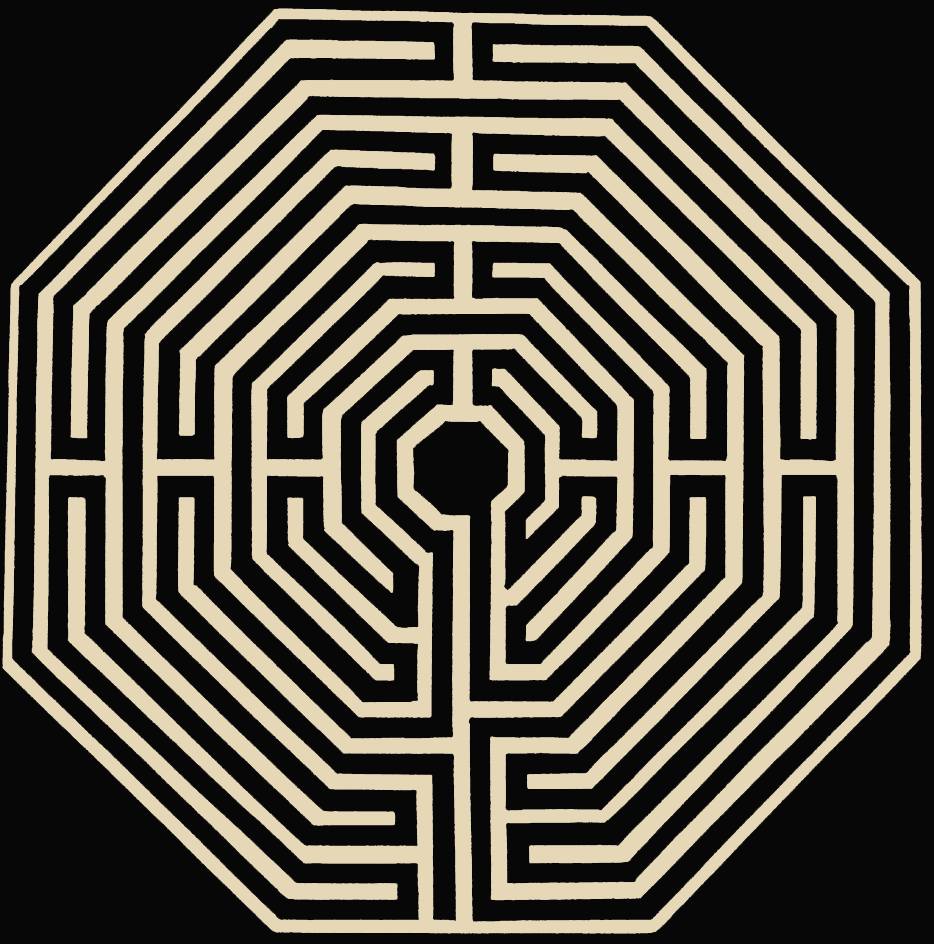
As one progresses on into the nave, one meets
the labyrinth of the New Jerusalem. The term, the New Jerusalem, is a grand
and specific title for the cathedral. Even in physical appearance the cathedral
was required to be so resplendent as to remind one of the New Jerusalem.
Of course the term was also symbolic. In general one's work within the
cathedral was the building of the New Jerusalem, the body of direct consciousness
of the "divine", and this applied specifically to the labyrinth.
First, the background on the labyrinth as it could
be used by anyone. In medieval times, when pilgrimage was still part of
Christian life, it was the Christian's desire to go to Jerusalem, in the
same way it is for Moslems to go to Mecca. But if a person could not afford
either the time or money to go, this labyrinth would accomplish the same
purpose. People wishing to use the labyrinth as a pilgrimage, did so on
their knees, moving along its path, praying fervently. The time it takes
to complete the diagram is two hours; the reputed time it took for Christ
to carry the cross to Calvary. It is known as the Way of Patience, and
unlike most other symbols in the cathedral was actually used and practised
by the parishioners.
Only two other cathedrals in France have these
diagrams correctly, Chartres and Amiens. Unfortunately when the floor in
Amiens was re-installed with new stone, the labyrinth was incorrectly moved
farther up the nave. This is critical because in actual practise, if a
person did not feel that she/he could penetrate the interior of the space
any further than the labyrinth, she/he did not proceed past it. This indicated
that the cathedral was no longer an inanimate "thing" but was now a living,
breathing being, a guide and reflector of one's actual being conscious
in reality. To make use of the cathedral as one's work-partner meant that
it truly became a sacred space in the most exacting and intimate sense.
In this way it actually became the blue-print for the divine body that
one was consciously constructing out of one's being communion with the
entirety of the work which the cathedral and one's efforts symbolized.
When "both partners" co-emerge unoriginatedness the work is complete. The
real sense of the word implied by "Tantra".
The labyrinth is in the form of an octagon, and
many of the symbols are based on the number EIGHT. To the medieval church,
eight was the number of progression, the basic situation in the cathedral:
the progression from darkness (ignorance) into light (illumination). This
was restated by the form of the baptismal font, typically eight-sided.
The diagram ITSELF is a simulation of the typical
human situation.The lines of the graph show that sometimes life looks twisted;
there are many complex turns one after the other, difficulty in seeing
where one has been and where one is going. Sometimes the road is straight
and broad with a long-range viewpoint. Sometimes close to the center, sometimes
on the edge.
The maze is a surprise. (Perhaps what is meant
by the word a- maze-ment!) Just looking at it and considering the importance
of the center, the Point of Illumination/Enlightenment/Awakening, one might
think that one works first around the edges and slowly approaches center.
That's logical. Walk the labyrinth and find what happens.
The church's excommunication of gnostic knowledge,
including the processes of incarnation, did not squelch either its transmission
nor the activation of the processes by initiates. (Until the Nicene Council,
the doctrine and inner practices of reincarnation were in active use in
certain communities.)
To the "divines" as they were called (a person
able to meditate on the divine mysteries) the labyrinth was the Thread-of-
Life....life being taken as the event between one birth and death, and
also a series of these events comprehended as one lifetime. The initiate
looks at the first step into the maze as incarnation. During the passage
of the labyrinth, one applies intense self-remembering or self-re-collecting
meditations. In this process one's negative blocks, attitudes, and emotional
states are triggered. The idea is to dissolve these, to transform them,
even if that requires many trips through the maze. If one cannot go past
a certain point in the maze, this means that one is at an actual block
in one's life that has to be recognized and transformed before any further
progress can be made. Upon reaching the center there is a symbolic dying
to the world (which is more real than dying "in" the world), the ending
of all obscuration and occlusion towards illumination. In this illumination
one sees one's karma, re-collects one's life work, becomes synonymous with
one's dharma, Truth.
During "close approaches" to this central chamber
one may experience partial illuminations whereafter there may be ejections
back into various sections of the labyrinth. These passages through states
of fluctuation and uncertainty are due to the identifications and attachments
to limitation that the being is still carrying. When all attraction/repulsion
is brought into neutral equivalence, being is irrevocably drawn to the
center. If one is able to endure the scale of eternity represented by the
ratio of the totality-of-one's-knowledge-of- the-world to the totality-of-one's-being-in-the-world,
and if this is realized to be Void, there is a simultaneous expansion/contraction
from center to circumference/circumference to center, in which both aspects
absorb one another.
In this chamber one lives a new form of consciousness
which is formless. The central chamber represents the Void of the Unborn,
the Pre-birth Module in which it is possible to be conscious without becoming
entangled in the apparencies of birth/sex/death/transit. This is the "seed-bed"
in which the Tree of Co-emergence is nurtured.
Now begins a new life. One appears to pass beyond
the labyrinth into an area of a rectangle of specific proportions; the
Greeks called it the golden mean, the golden door. It is symbolized by
a uniform pattern of black and white diamonds. The golden section, the
unmoving flow of equilibrium, is the conscious effect perceived during
the expansion/contraction in the central chamber. It is the nature of the
labyrinth to spontaneously dissolve itself. Like a magic spell it vanishes
without ever having existed. Since this could not be shown as a spacial
superimposition, the golden door had to constructed as a sequential aspect
to the labyrinth. Once this recognition of moving stillness is completed,
one "finds" oneself spontaneously transferred to the center of the next
symbol. Convenient, eh?
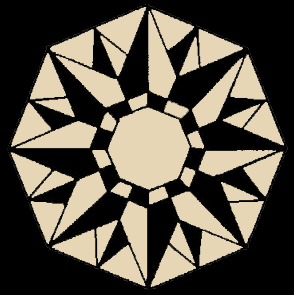
At the grand transept is the Octave of the Omnidirectional
Emptiness, as symbolized by the gigantic and complex sixteen-pointed star
set within an octagon, at the cross-roads. For the first time the journey
is intercepted by a great crossing. Having passed through the labyrinth
of phenomenal "otherness", the essence encounters the deep essential habits
toward unconsciousness, habits that eventually lead into involuntary rebirth.
The phenomenal is the identification with change or transitoriness. The
non-phenomenal is the identification with sameness, non-change, eternalness.
If one can stabilize consciousness within the heart center represented
by this symbol of radiance, it is possible to translate directly to the
great void of voids. This translation possibility is indicated by the great
keystone of the central vault which is suspended above the center of the
transept star, and through which a line can be passed from the floor to
the keystone to the intersected tip of the spire, symbolizing the zenith,
the passing beyond all infinities.
The four immense arches of the central vault that
join all the parts of the cathedral, are like four ventricles or transforming
chambers which merge into a unified fifth central opening. Through this
area circulate the winds or "breaths" of the four quarters corresponding
to the four "humors" or "types" of humanity as a physical-emotional-thinking-essence.
If these are rhythmically harmonized with one another, they can reach a
state of equilibrium which allows them to blend with the all-pervasive
breath of inspiration which flows into the innate light of that which is
beyond all presence or absence. This merging takes place at the central
heart of hearts symbolized by the star/keystone/spire.
The force enabling one to bring about this harmonization
of higher breathing is represented by the fusing illumination coming from
the north, south, west and east rose windows (of which only Laon cathedral
has a complete set). If the architecture, light and dimensions of the cathedral
are exactly tuned, this fusion of light and geometry acts as a superamplifier
which spontaneously brings consciousness to a state of stabilized wakeful,
ecstatic equilibrium, which is the natural state of the human.
However... if there are any residual habits persisting
toward existing in any non-phenomenal sameness, one works in the corresponding
domain of sameness until one is clear of that habit. The choir is analogous
to these domains.
As at all other stations along the way, guides
appear when the work at hand requires. Should one need to pass into the
choir for purification work related to the "unveiling of the higher bodies",
there is a final reminder from the transept windows. The southern rose/star
is a mandala, once again illuminating the principle of "four", recalling
one to the center of directionality, one's true orientation. This state
in consciousness clears the obscurations that impress one with notions
of being unguided. As one is on one's true course it is recognized as such.
There are no accidents, no deviation, no mistrust and no projections. The
five-pointed star/rose in the north transmits the reminder that this stability
is to be opened into a universal mode, the pentagram. Humanity, in its
aspect as a five- centered form, brings those centers (sex, instinctive,
moving, emotional, thinking) into a harmony that is capable of functioning
within the eternals, or degrees of sameness, of the choir domain.
The choir represents the pure components of consciousness
which dissolve all remaining tendencies toward unconsciousness whatsoever.
They find their equivalence in the various orders of "angels, archangels,
etc.", each with their appropriate color, as described in Christian mythologies.
Form-of-consciousness, perception, feeling/sensation, concept, form, dimension,
motion - all of which constitute the totality of the cathedral and the
work which it embodies are progressed through as the choir is consciously
imbibed and transcended. This imbibing and transcendence are merely realizations
of the deeper potentialities of being and are in no way "independent" from
or "objective" to the true nature of being as such. In this situation "humanness"
is no longer a constraint to being.
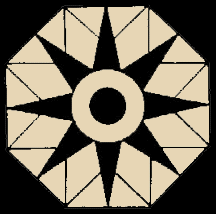
Whereupon one arrives at the petit transept. The
symbol here is also a sixteen-pointed star within an octagon, but it is
as simple as possible. It embodies the first symbol of unity, the cosmic
center, which appeared within the seven-pointed star. The state to be realized
is this: that within all transition, within all apparent steps, is the
eternal, the permanent unity. Under all conditions one sees the light within
the darkness.

In the far north corner of the petit transept
is once again a seven-pointed star; one of the branches is aligned to due
north, taking St. Quentin's declination into the formula. But its real
significance is that it contains a circle without a point. This is the
symbol of a human who has realized within hirself the centerless center;
this is true alignment/orientation. Another symbol close by is a square
containing an eight-pointed "explosion". Within the explosion resides the
cosmic center. This "shock" is the recognition that the cosmic center is
not a far-off twice removed focus, but is also present as the finite. What
is there to transform when the finite is already infinite?
It is also a symbol for the conscious enneagram.
An unconscious enneagram consists of nine parts: the triangle of the three
permanent forces (affirming, denying, reconciling) and six "stations" within
which the transitory creates a bounce pattern. The enneagram pattern allows
for the introduction of two shocks from "other" enneagrams which infuse
new energy into it, thereby helping to consciously evolve the octave to
the next scale in being. When the enneagram becomes conscious, all parts
(the octagon) are seen as the emanations of a single focus in being (the
cosmic center). As emanations, even the permanent and the impermanent become
equal in the play of consciousness. (The three and the six co-equally fuse
eternally into the Seven Mirrors Of Perfection, which spontaneously translates
into the Octave.)
Out of necessity these symbols appear in the northern
arm of the transept because an observation on the north pole star (sky-symbol
for the cosmic center) cannot be taken from the southern arm.
It would be well to note that these transepts,
grand and small, also correspond to the shocks in the theory of evolution
as portrayed by the enneagram.
The first shock comes early and is an assistant
from an apparently external force, here symbolized by the message in the
grand roses: that no matter how chaotic or fragmented the journey may appear,
one's friends and guides are everywhere. Not a single situation is unguided,
if one but cares to be conscious of this. Voidness cannot be lost nor found.
The second shock seems small but is the most difficult.
It comes at a stage just before completion. The assistance comes from within,
as indicated by the presence of the cosmic center inside each symbol. Eight
as an "even" number is an inexactitude. The "shock" of this law conformable
inexactitude comes through recognition that all symmetrically mirrored
rest is unstable because it tends toward decay. All compounds (aspects,
images) decay. There are no images of God. To be able to go "through the
looking glass", the one who is "looking" must give up one's most holy "image
of god" in order to be able to truly see. The mirror is empty; nothing
is full.

The last symbol lies beyond the sanctuary. A hexagon
encases a six-pointed star which contains a hexagonal crystal... the form
of the primitive cut of the diamond. For the realization of the diamond
body, the body of perfection, one has made this journey. Standing before
the chapel of the East, one can see that within, it is dedicated to the
Virgin, symbol of the Ultimate Wisdom. The Virgin is holding the Christ
Child, who is the one standing before the chapel. And this is the "mystery"
of the Virgin and the "mystery" of the Cathedral, the Cathedral Notre Dame:
a virgin is a virgin is a virgin. She never has brought anything forth
and never will, and therefore will never complete or return anything that
was never brought forth. "Although I have led many countless beings into
Parinirvana, I have not led a single being." Perfection is, for Perfection's
sake. This has only been a journey through Consciousness, but it is just
as well and just the same anyway, as voidness only perfects voidness. All
aspects - "heaven, hell, purgatory" - are equally real and unreal to the
ultimateless.
Most cathedrals have a west rose with a final
message, the last judgment, the ending of time; the time for the "world"
has run out; there was no past and there will be no future and no one is
ever present. And as for the existence of eternities, of what use are they
with no time to compare them to?
The illusory rainbow body of the cathedral retracts
and all that continues (as ever) in unbroken uniformity is the ineffable
laughter of Voidness.


 Next
Next